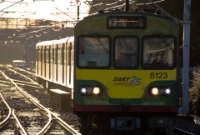Howth Junction
Howth Junction, on the Dublin to Belfast main line, is where the short 1847built line to Howth diverges. Up to 1912, Howth Junction station was simply known as 'junction'. The station, which has four platforms, up and down for both the Howth and Belfast lines, had at one time station buildings located on the centre platforms, but these have long since been demolished. The signal cabin at the south end of the station, a unique Great Northern Railway type, was unfortunately demolished following the electrification of the branch to Howth with the commencement of DART trains in 1984. Up to 1999/2000, Howth Jct was an interchange with diesel services to the north to Malahide and beyond but today the DART trains now terminate at Malahide, following the extension of the wires north of the junction. In recent years the station has been totally rebuilt, with a new footbridge and booking offices on either side of the lines.






























